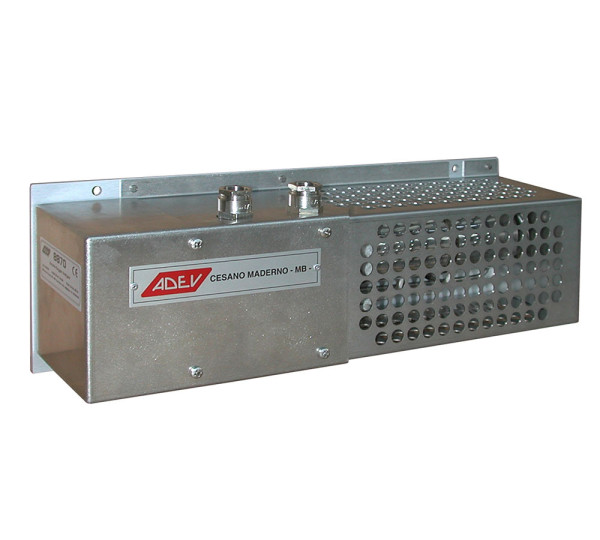Gasanalyse
8870 Zirkoniumoxid Sauerstoffanalysator
Rugged Zirconia analyser for ppm or % Oxygen measurements in combustion & inert gas.
The 8870 is an extractive Zirconia Oxygen analyser that is typically employed for O2 trace measurements in pure gases (typical in technical gas production industry) or in heavy duty applications thanks to an extremely rugged sensor.
Rugged Zirconia analyser for ppm or % Oxygen measurements in combustion & inert gas.
The 8870 is an extractive Zirconia Oxygen analyser that is typically employed for O2 trace measurements in pure gases (typical in technical gas production industry) or in heavy duty applications thanks to an extremely rugged sensor.
Measureable Gas
Oxygen [O2]
Main Features
- Extreme Roughness
- No inner moving parts
- Installation position and vibration don’t alter the accuracy and stability of the measure
- Insensitive to ambient temperature variations
High Performances
- Inner reference air that eliminates the effect pf barometric pressure variations
- Extremely fast response time
- Excellent long term stability
- Available as 4-20 mA transmitter or combined with a powerful microprocessor-based control unit
Easy Maintenance
- Modular construction
- Fast access to the inner PCB just unscrewing the AISI cover
European Compliance
- Low Voltage Directive 2014/35/EU
- EMC Directive 2014/30/EU
|
Performance Specification |
|
|
Accuracy |
with control unit: ± 1% of span or ± 1 ppm (whichever is worse) |
|
Repeatability |
± 0.5% of span (short term). |
|
Linearity |
better than ± 1% of full scale |
|
Response Time |
Initial < 0.1 sec.; 90%: < 1 sec. |
|
Drift |
Zero: max. ± 1% of span per week |
|
Ambient Temp. Influence |
max. ± 0.06% of reading per °C |
|
Atm. Pressure Influence |
Free vent: no influence Pressurized vent: ± 0.1% per hPa |
|
Flow Rate Influence |
less than 0.3% of span over flow range of 100 to 200 cc/min. |
|
Line Voltage Influence |
max. 0.02% of span, for each 1% change of power voltage. |
|
Gas Interference |
combustible gases + O2 reduce the measure |
|
Operative Specification |
|
|
Sample Requirements |
Sample Flow Rate: 100 ÷ 300 cc/min. Pressure: 3000 Pa minimum (with filter and flow meter). |
|
Reference Requirements |
Dry and oil-free instrument air at Flow Rate: 100 ÷ 200 cc/min. (max. 500 cc/min.) |
|
Range |
Refer to ordering information |
|
Output |
Standard 8870 sensor output: logarithmic 50 mV/decade functioning as input of control unit that operates calculation, linearization and retransmits the isolated output current. Transmitter version: 4-20 mA proportional to ordered range; max. load 500 Ω (or 350 Ω with galvanically insulated module) |
|
Diagnostic NV Logical Output (non-valid) |
Logical Non Valid output from relay free contact. Normally supplied in fail safe condition (triggered relay and closed contact if not in alarm). Can be modified in filed |
|
Relative Humidity |
90% maximum. |
|
Operation Temperature |
-10 ÷ +50°C (14 to 122 °F ). |
|
Temperature controlled |
at 700°C |
|
Storage Temperature |
+70°C (158 °F) max. |
|
Power Requirements |
22 ÷ 30 Vac, 200 VA from dedicated power supplier. |
|
Pneumatic Connections |
Sample IN, sample OUT, reference air: 1/8” NPT-F |
|
Wiring Connections |
N°2 cable glands for cables 10 ÷ 12 mm |
Applications
- Gas production industry (purity monitoring of N2, Ar, He, CO2)
- Air Separators
- Nitrogen Generators
- Heat treatments
- Mixers
- Welding Gas
- Combustion Gas
- Endothermic Generators
- Any application for ppm or % O2 measurement in inert gas or combustion gas
Sampling System
The 8870 needs an external sampling system able to deliver an almost clean sample gas to the analyser at the proper temperature, pressure and flow rate.
ADEV has a wide experience in process and can provide the 8864 analyser combined with a sample and condition system designed for the specific application requirements. Contact ADEV for details
Measuring Principle
The measuring principle on which the analysis is based is linked to the use of Zirconium oxide which, at high temperatures, can behave like a solid state electrolyte, developing an electromotive force on two electrodes placed in contact with different O2 concentrations (partial pressures), proportional to the temperature in Kelvin degrees (°K) and the logarithm of the ratio between the two pressures PO2’ and PO2” in accordance with Nernst’s well-know ratio:
E = RT / nF (Lg P02’ / P02“)
Where:
R = Perfect gas constant (8,31 Joule/degree bulk)
F = Faraday’s constant
T = Absolute temperature in °Kelvin
n = 4










